



Thermostabiity of Salmonella in Dried Egg White Investigated
ARGENTINA - A team of researchers has been investigating the time and temperature required for the elimination of Salmonella bacteria in dried egg albumen.In recent years, Argentina Investigata (Dicyt) reports, dry foods have been associated with outbreaks of salmonellosis, forcing a reevaluation of the microbiologically safety of low-moisture foods. That is why a team of specialists has been investigating the times and temperatures required for the elimination of Salmonella bacteria in dried egg albumen.
Liliana Lound, project director of the School of Food Science at the National University of Entre Ríos, told Argentina Investigates that she has been studying the destruction by heat of three Salmonella serotypes isolated and inoculated in dried egg albumen. This information on the temparature resistance of the bacteria will contribute to the optimisation of the heat treatment of dry foods.
When the critical temperature for each microorganism is exceeded, irreversible protein denaturation and death occur. To ensure microbial thermal destruction, it is necessary to understand the relationship between time and temperature under certain conditions to ensure the destruction of these bacteria present in food.
According to the Argentina Chamber of Poultry Producers (Capia) egg production in Argentina reached 9.880 million units in 2012, and around 10 per cent of this is processed into pasteurised egg powder or liquid. The yolks may be separated for use in mayonnaise, sauces and ice cream, while the albumen is used as a food supplement in, for example, soups, diet drinks, cheese and pharmaceuticals.
There is also a good prospect for these products in be used as nutraceuticals or ingredients for functional foods to rpomote human health and/or reduce disease risks. Egg albumen is attractive as a source of bioactive peptides for the prevention or treatment of coronary heart disease.
Assessment of Thermotolerance of Salmonella
The egg industry uses different pasteurisation temperatures to produce egg products with different whipping or gel-forming characteristics.
So in this work, the physical and chemical characteristics of the albumen were measured in addition to the thermal tolerance in dried egg albumen of isolates of three serotypes of Salmonella enterica: S. Enteritidis, S. Typhimurium and S. Montevideo.
The egg product was pasteurised at 72, 77 and 82°C.
Salmonella survival was studied in a cocktail of strains and mixed inocula formed from the most heat-resistant strains of each serotype. Additionally, the response to heat shock, after heating at 50°C for 30 minutes was evaluated.
Dr Lound explained that thermotolerance of the Salmonella strains studied depended on genetic factors and water activity rather than the heat shock. Mixing the strains as a mixed inocula did not affect thermal resistance, which were approximately 3.5 hours at 72°C and 30 minutes at 82°C, measured as the time required to reduce the Salmonella level by an order of 10.
The results are significant in the field of food technology and food safety, she said, allowing the dry pasteurisation conditions to be adjusted to produce products that are microbiologically safe and with the right properties for their future use.
The studies were made possible by the collaboration with the egg industry.








